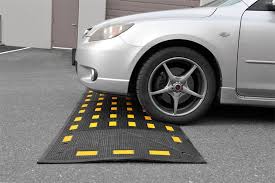Speed bumps are a common traffic calming measure employed in various settings, including residential neighborhoods, school zones, parking lots, and industrial areas. Their primary purpose is to reduce vehicle speeds and enhance road safety for all users. Here’s an in-depth look at the various ways speed bumps contribute to improving road safety.
1. Reducing Vehicle Speed
The most obvious and primary function of speed bumps for road projects is to slow down vehicles. Speeding is a major factor in road accidents, contributing to both the frequency and severity of collisions. By forcing drivers to reduce their speed, speed bumps help mitigate this risk.
When vehicles travel at lower speeds, drivers have more time to react to unexpected events, such as a child running into the street or a car suddenly braking ahead. This reduction in speed can significantly decrease the likelihood and severity of accidents.
2. Enhancing Pedestrian Safety
Speed bumps are especially beneficial in areas with high pedestrian activity. In school zones, residential neighborhoods, and near parks, pedestrians, including children and the elderly, are at greater risk of being hit by fast-moving vehicles.
Speed bumps compel drivers to slow down, making these areas safer for pedestrians. Slower speeds mean that even if an accident does occur, the impact and potential for serious injury are greatly reduced. Additionally, drivers are more likely to stop for pedestrians at crosswalks when they are already traveling at reduced speeds.
3. Encouraging Safe Driving Behavior
The presence of speed bumps can promote overall safer driving habits. When drivers encounter speed bumps regularly, they become more accustomed to driving at safer, more controlled speeds. This behavioral change can extend beyond the immediate vicinity of the speed bumps, encouraging safer driving throughout the community. Over time, consistent exposure to speed bumps can help cultivate a culture of cautious driving.
4. Reducing Traffic Noise
High vehicle speeds often correlate with increased traffic noise, which can be disruptive and detrimental to the quality of life for residents in the area. Speed bumps help to reduce this noise by slowing down traffic. Lower speeds result in less engine noise, tire noise, and overall vehicular commotion. This noise reduction can make residential and pedestrian areas more pleasant and livable.
5. Improving Safety in Parking Lots
Parking lots are environments where low-speed limits are crucial for safety due to the high density of vehicles and pedestrians moving in confined spaces. Speed bumps in parking lots ensure that vehicles move slowly, reducing the risk of accidents involving both vehicles and pedestrians. By controlling speed, speed bumps help prevent fender benders and enhance overall safety for shoppers, employees, and visitors.
6. Aiding in Traffic Management
Speed bumps can also serve as a tool for better traffic management. By strategically placing speed bumps, traffic engineers can influence driver behavior and direct traffic flow more effectively. For instance, speed bumps can be used to discourage through-traffic on residential streets, diverting it to more appropriate main roads. This helps reduce congestion and enhances safety in quieter neighborhoods.
7. Protecting Vulnerable Road Users
Certain road users, such as cyclists and motorcyclists, are more vulnerable to accidents due to their exposure and lower visibility. Speed bumps contribute to their safety by slowing down vehicular traffic in shared spaces. Slower vehicle speeds reduce the risk of collisions with these vulnerable road users and provide them with a safer environment to navigate.
8. Decreasing Accident Severity
Even when accidents do occur in areas with speed bumps, the severity of these incidents is typically lower. Reduced vehicle speeds mean that the force of impact is lessened, resulting in fewer serious injuries and fatalities. This is particularly important in residential areas where children and elderly pedestrians are more likely to be involved in accidents.
9. Encouraging Compliance with Traffic Laws
The presence of speed bumps often results in higher compliance with local speed limits and other traffic laws. Drivers who encounter speed bumps are more likely to adhere to posted speed limits and other regulatory signs, knowing that failure to do so will result in an uncomfortable or potentially damaging encounter with a speed bump. This increased compliance contributes to overall road safety.
10. Cost-Effective Safety Measure
Speed bumps are a cost-effective way to enhance road safety. Compared to other traffic calming measures like roundabouts or traffic signals, speed bumps are relatively inexpensive to install and maintain. Their effectiveness in slowing down traffic and reducing accidents makes them a valuable investment for municipalities looking to improve safety without incurring significant expenses.
Enhancing Road Safety with Speed Bumps
Speed bumps play a crucial role in improving road safety by reducing vehicle speeds, enhancing pedestrian safety, and encouraging safe driving behaviors. They help manage traffic flow, protect vulnerable road users, and decrease the severity of accidents. Additionally, speed bumps are a cost-effective solution for municipalities aiming to create safer and more livable communities. By understanding and leveraging the benefits of speed bumps, people can foster safer roads and more secure environments for all road users.

